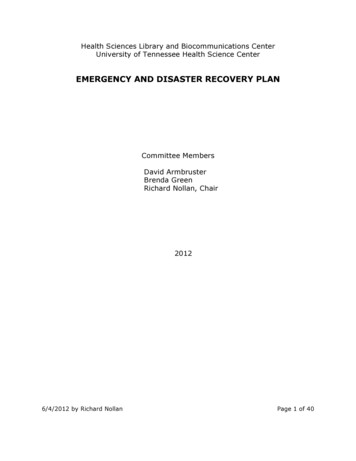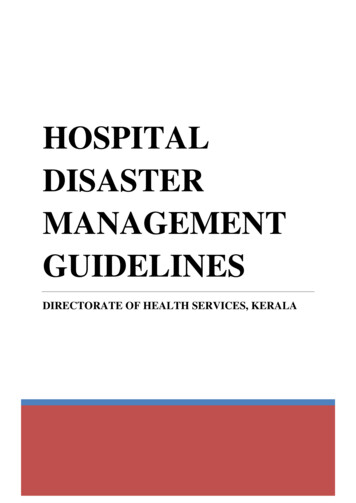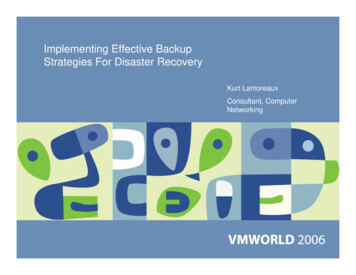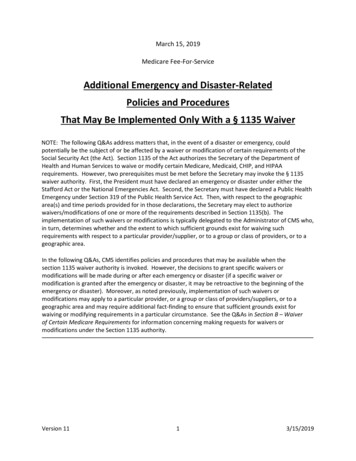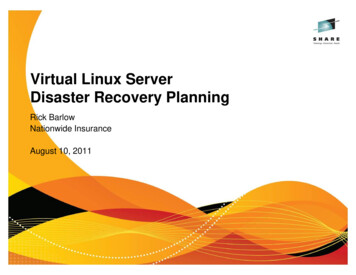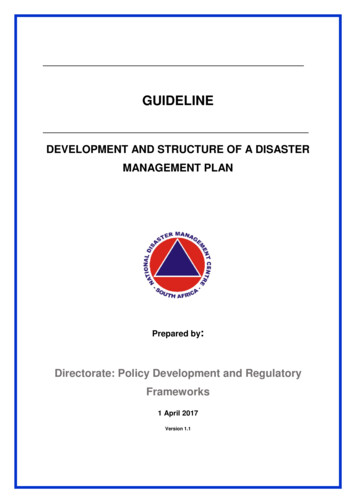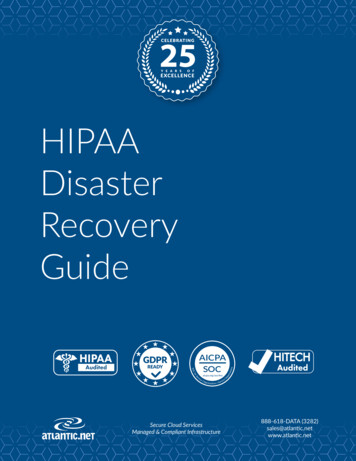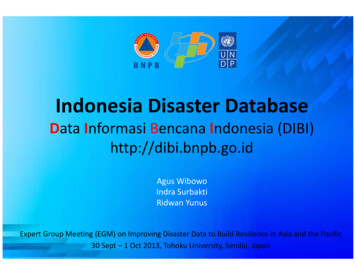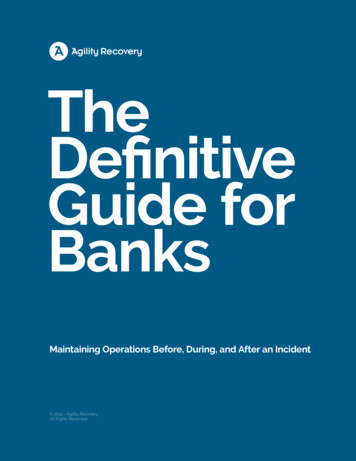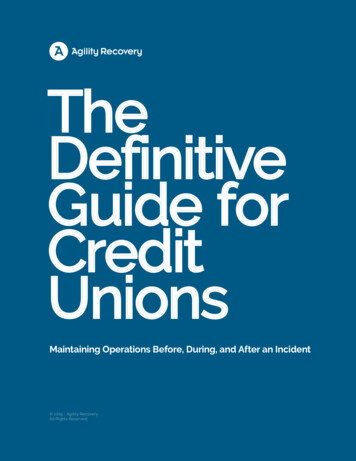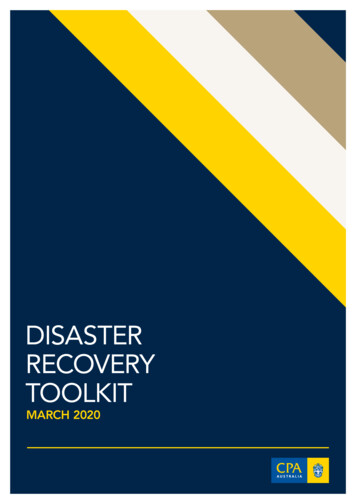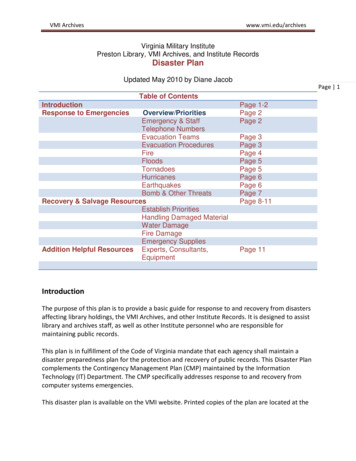
Transcription
VMI Archiveswww.vmi.edu/archivesVirginia Military InstitutePreston Library, VMI Archives, and Institute RecordsDisaster PlanUpdated May 2010 by Diane JacobPage 1Table of ContentsIntroductionResponse to EmergenciesOverview/PrioritiesEmergency & StaffTelephone NumbersEvacuation TeamsEvacuation Bomb & Other ThreatsRecovery & Salvage ResourcesEstablish PrioritiesHandling Damaged MaterialWater DamageFire DamageEmergency SuppliesAddition Helpful Resources Experts, Consultants,EquipmentPage 1-2Page 2Page 2Page 3Page 3Page 4Page 5Page 5Page 6Page 6Page 7Page 8-11Page 11IntroductionThe purpose of this plan is to provide a basic guide for response to and recovery from disastersaffecting library holdings, the VMI Archives, and other Institute Records. It is designed to assistlibrary and archives staff, as well as other Institute personnel who are responsible formaintaining public records.This plan is in fulfillment of the Code of Virginia mandate that each agency shall maintain adisaster preparedness plan for the protection and recovery of public records. This Disaster Plancomplements the Contingency Management Plan (CMP) maintained by the InformationTechnology (IT) Department. The CMP specifically addresses response to and recovery fromcomputer systems emergencies.This disaster plan is available on the VMI website. Printed copies of the plan are located at the
VMI Archiveswww.vmi.edu/archivesCirculation Desk; in the VMI Archives; and at the homes of the Library Director, Head ofArchives & Records Management, and Head of Access Services.This disaster plan will be revised and reviewed and updated annually by the Head of Archivesand Records Management. (currently Diane Jacob).Response to Emergencies-OverviewResponse to emergencies is based upon the following priorities:1. Most importantly, safeguard human life. Evacuate the building promptly, and call for help.2. Assess and contain the damage to collections if it is possible to do so safely.3. Salvage as many library materials as possible, beginning with the rare materials in Archivesand Special Collections.4. Staff of departments other than the library should focus on saving vital operational recordsfirst; then prioritize salvage of remaining items.Emergency Telephone NumbersFire-Ambulance-PoliceVMI Post PoliceVMI Guard RoomVMI Physical Plant9119-463-917772947357Preston Library PersonnelNameOfficeEmergency(prefix 464 from off-Post)Brickler, MichaelFlanagan, AccaciaHastings, SusanHolly, JanetJacob, DianeKirby, NancyKludy, Mary LauraMoore, TonyaNewman, MeganPage, BriannaPanko, TomSamdahl, DonSichol, GwenSmith, PatsyTombarge, Brittany765572507607 or 712972967566756575167129 or 7-9398464-5174; 460-4534 (C)291-4281463-9413; 817-9157 (C)463-9284; 817-9368 (C)264-0136997-1224, 874-4769 -9280570-3034Page 2
VMI ArchivesWells, Cathywww.vmi.edu/archives7567463-9365Evacuation Procedures and Accountability TeamsThe Building Coordinator for Preston Library is Don Samdahl. Susie Hastings is the alternate.The responsibility of the Building Coordinator is to insure the safe evacuation of all personnelfrom the building in the event of an emergency. If the Building Coordinator is absent theAlternate will assume this responsibility.In the event of an emergency we will do the following:Insure each floor of the Library is clear of personnelInsure handicapped persons are evacuated or moved to Areas of Rescue AssistanceInsure accountability of all Library personnelFloor Evacuation Responsibilities of Library Personnel (team leader in red)Floor700, 650, 600500, 550400300200Evacuation TeamsJanet Holly, Brianna Page, Gwen Sichol, Megan NewmanSusie Hastings, Accacia Flanagan, Tonya MooreMichael Brickler, Cathy WellsDiane Jacob, Mary Laura Kludy, Nancy KirbyTom Panko, Patsy Smith, Brittany TombargeWhen there is an emergency (most likely the alarms will be going off) the Evacuation Teams willgo to their assigned floors to facilitate evacuation of personnel and to determine if there areany handicapped patrons who cannot exit the building using the stairs or who need assistancein some manner. If you find anyone in this condition move them to the appropriate Area ofRescue Assistance.When the floors are cleared we will assemble outside the Library on the Parade Ground andconduct a final accountability. The Evacuation Team leaders will report to the BuildingCoordinator regarding any people who have been moved to an Area of Rescue Assistance. TheBuilding Coordinator will then give the status of the Library up the chain of command.The Areas of Rescue Assistance are located on 650 and 550 on the NE external stairs. On the200 level they are located at the Library’s loading dock and outside of the custodians’ office.Non-designated Areas of Rescue Assistance may be considered to be the SE and SW stairwells.On the 300 level someone could be evacuated out the double doors that face Mallory. Thesedoors are normally locked and would require the OUT key to open them.Page 3
VMI Archiveswww.vmi.edu/archivesFireIf the fire alarm is activated, it may be the real thing. Do not assume that it is a false alarm. When thealarm sounds, do the following:Identify location of activated alarm from the fire alarm panel near the front door of the library.Either go yourself or send someone to investigate the area to see if there really is a fire.DO NOT USE THE ELEVATORS.IF THERE IS A FIREYour first priority is to ensure the safety of people in the building.If a fire cannot be easily and safely extinguished, call 911 & VMI Post Police (463-9177) andproceed to evacuate the building. Err on the side of safety—if in doubt, evacuate!Use common sense and don't panic. A minor, contained fire (trash can fire, for example) can beextinguished with the fire extinguishers located on each floor.Evacuation Procedures – FireEvacuation of the building should begin immediately after the fire has been positivelyidentified and cannot be safely extinguished by a staff member using a fire extinguisher.DO NOT USE THE ELEVATOR: use stairs onlyAvailable staff members should proceed to a designated control center (in PrestonLibrary, the Circulation Desk) to review assignments for clearing the building. Check inbefore and after going to your area of responsibility.If you are on duty by yourself, begin to systematically clear each floor until help hasarrived.Designated staff will be responsible for assisting handicapped persons. Be sure that theevacuation teams check every floor.Copies of floor plans are located at the Circulation Desk and are wall-mounted on eachlevel.FALSE ALARM- No FireIf it is a false alarm, open the alarm panel with the key tagged FIRE SYSTEM, which is kept inthe key box located on the shelf in the Reserve Section. You will find a second key on the ledgeinside the alarm box. Insert this other key in the ENABLE /DISABLE slot. Turn to DISABLE andpress the ALARM SILENCING button and then the button marked NEXT/ACK till the date andtime reappear. Lock the panel and replace the key in the box on the shelf.Page 4
VMI Archiveswww.vmi.edu/archivesFloods/Water EmergenciesIf there is a serious leak, broken pipe, or a flooded area in building, call Buildings &Grounds at 464-7357 and state that you are reporting an emergency water problem.After hours, notify the Post Police and request that they contact the designated B&Gstaff.If water is leaking from the ceiling, cover the area with plastic sheeting (in supply closeton 5th floor of Preston Library). Place buckets under leaks. Buckets are located injanitor's closets.If there is water on the floor, remove books or records from lower shelves/file drawersonto higher shelves or tables well away from standing water. Do not place any materialon the floor, even in a seemingly dry area, as the leak may spread.If possible, turn off electrical circuits to the flooded area, and unplug electricalequipment in the area if you can safely do so. If electricity in the building needs to beturned off, call Buildings & GroundsThe building needs to be evacuated only in case of major water damage and whenstructural damage can be expected. The decision to evacuate should be made by thedepartment head, who will organize a team to assist in evacuation.TornadoesTornadoes can occur in Virginia from March to October. They are not as likely to occur inmountainous regions as in more flat terrain. Tornadoes move rapidly. Most likely, there will belittle warning if there is a tornado; consequently, there will be little time to seek shelter.When a tornado occurs, the building should not be evacuated.If possible, persons in the building should move to the lowest level, staying away fromwindows; or to an inner hallway or small inner room away from windows.DO NOT USE THE ELEVATORS. In the library, stay away from book stacks, since they maycollapse.If there is time, staff should go to the 300 level computer lab, which has been equippedwith a rechargeable flashlight plugged into an electrical outlet to the left of the door, aswell as a whistle that can be used to alert rescuers.After the event:In addition to water damage, walls, ceilings, and shelves may collapse. When structuraldamage occurs, the person in charge of the over-all building maintenance needs toassess the structural damage and determine when it is safe to enter the building toassess damage and begin salvage efforts.Page 5
VMI Archiveswww.vmi.edu/archivesHurricanesHurricanes may occur on the Atlantic Coast of Virginia between June and November. Damagefrom heavy rain and flooding as well as high winds may occur. Hurricanes are slow moving soprecautions can be taken before the storm actually strikes.EvacuationBecause sufficient warning can be given in a hurricane emergency, the building can beevacuated and closed before the hurricane strikes. The following precautions should be made:rare and valuable materials can be moved to a safe place; the power can be turned off;windows should be taped to reduce the danger of flying glass; and doors should be closed. Ifthere are people in the building when the hurricane strikes, they should move to the lowestlevels of the building, such as the basement level or the lower stacks and not leave until thestorm is over. A battery-powered radio should be available so that weather reports can bemonitored.DamageMost damage from a hurricane will be water damage, although there is a possibility ofstructural damage, broken windows, and collapsed shelving. If there is structural damage, theperson in charge of the over-all building maintenance needs to assess the damage anddetermine when it is safe to enter the building. Then, damage to affected materials needs to beassessed. The recovery operation for library materials may include surveying water damage tobooks and other library materials, reshelving, and deciding upon repair of broken windows.EarthquakesEarthquakes may occur in Virginia. The danger from earthquakes is caused by what they do toman-made structures-debris falling from damaged buildings, flying glass from broken windows,fires caused by broken gas lines, and flooding due to broken water mains. There is no warningbefore an earthquake occurs.If an earthquake occurs, do not attempt to evacuate the building. Persons in thebuilding should stay in the inner core of the building away from windows. Shelter shouldbe taken in a doorway, in a narrow corridor, or under a heavy table, desk, or bench.Exits which lead into stairways should not be used because they may have collapsed.Also, be aware that after-shocks may follow for several hours or days after theearthquake. A battery-powered radio should be available so that instructionsconcerning the earthquake can be monitored.Damage from an earthquake may include structural damage to the building, collapsedshelving, damage to equipment and furniture, water damage from broken pipes, andfire and/or smoke damage caused by broken gas lines. All damage will need to beassessed by person in charge of building maintenance before re-entering to beginrecovery operations.Page 6
VMI Archiveswww.vmi.edu/archivesBomb & Other ThreatsIf a bomb threat is received by telephone, evacuate the building and notify thePost Police, 463-9177. If a suspicious object or package is found, notify the VMIPost Police.The VMI printed directory contains a “threat checklist and telephone procedure”Page 7inside the front cover
VMI Archiveswww.vmi.edu/archivesRECOVERY AND SALVAGE—EXTENSIVE DAMAGEFOR 24 HOUR EMERGENCY CONSULTATION, CALL THENORTHEAST DOCUMENT CONSERVATION CENTERD I SA ST E R A SSI ST A N C E24/7 EMERGENCY PHONE ASSISTANCEDisaster Assistance Hotline:978-470-1010As part of its Preservation Services program, NEDCC offers an emergency assistance program forinstitutions and individuals with damaged paper-based collections.Review Damage & Establish PrioritiesRapid response is essential for an effective recovery effort. Paper-based collectionsbegin to distort physically immediately after becoming wet. Books swell and distort;paper cockles; inks and pigments run; coated papers begin to adhere.The Librarian, Archivist/Records Manager, and appropriate department heads or librarysubject specialists should evaluate damage and establish salvage priorities. ConsultYolanda Merrill, (Washington & Lee University, Leyburn Library) who is the only locallyavailable conservation expert.Archival records, rare books, records vital to the operation of the Institute, and anyother irreplaceable items should receive the first attention.Determine the kind and degree of damage that materials in each location havesustained. Depending on the extent of the disaster, this may be as broad as a room-byroom designation or as narrow as an item-by-item review.Determine whether the salvage operation can be handled by staff or whether a disasterrecovery specialist is required. Consult experts as needed.After reviewing the extent of the damage, the Librarian (in other offices, the appropriateadministrator), should set up a disaster recovery team and assign personnel as needed.Handling and Removal of MaterialThe most common emergencies (fire, flood) involve water damage. If possible, loosely sortmaterials according to degree of wetness (soaked, damp, dry). Pack like materials together,e.g. damp records in one box, soaked in another etc. See also specific instructions belowrelating to water damage and fire damage.Page 8
VMI Archiveswww.vmi.edu/archivesMaterials must be removed from affected areas, either to a salvage/drying areawithin the building, or to another area on Post. Likely locations are a classroom orgymnasium.Files: Place folders in boxes or milk crates. Place the folders vertically in boxes(standing as they would in a file drawer.) Fill boxes only about 75% full to allow forPage 9swelling.Bound Volumes: Load onto metal book trucks, or into boxes or plastic milk crates fortransport. Place normal-size volumes in a spine down position. Pack large volumesflat in boxes. If time allows, loosely place sheets of freezer paper or waxed paperaround every volume. Boxes should be packed only about 75% full to allow forswelling.To ensure inventory control and for insurance purposes, it is necessary to know thecondition and disposition of materials. As materials are removed, a staff membershould be assigned to label each container with a brief designation of its contents(by call number range; cabinet/drawer, record group etc.); damage type (wet, dry,smoke etc), and salvage priority; and destination.Assign a photographer to document the damage and salvage operations.Water DamageEvaluate the situation and decide whether the materials can be air-dried on-site or ifthey must be removed to a freezer facility. Refer to list of consultants for outsideassistance in evaluating the disaster. If the damaged materials are not too numerous ortoo thoroughly soaked, air-drying will be a viable option and a drying area will berequired. For detailed instructions on procedures to follow see the Northeast DocumentConservation Center's Technical Leaflet "Emergency Salvage of Wet Books and Records"(appendix in printed copy of this plan). A summary of key steps is listed below. Consultthe complete document for details.Secure a clean, dry environment where the temperature and humidity are aslow as possible. The temperature must be below 70 degrees F. and the humiditybelow 50%, or mold will probably develop and distortion will be extreme. Keepthe air moving at all times using fans in the drying area. This will accelerate thedrying process and discourage the growth of mold.Bookso Thoroughly soaked books, and books with coated paper should be frozenas soon as possible. Wrap them loosely in freezer paper or wax paper andpack them flat in boxes, preferably plastic mail crates, for transport to afreezing facility. If they cannot be frozen before they dry, interleave thepages with unprinted newsprint or paper towels. Keep an inventory ofbooks packed and removed to freezer facilities.o Wet books with covers intact can be air dried.
VMI Archiveswww.vmi.edu/archiveso Interleave every few pages, starting from the back of the book, turningpages carefully. For interleaving, use paper towels or clean, unprintednewsprint. Be careful to avoid interleaving too much or the spine willbecome concave and the volume distorted.o When books are dry but still cool to the touch, they should be closed andPage 10laid flat on a table or other horizontal surface, gently formed into thenormal shape, with convex spine and concave front edge (if that wastheir original shape) and held in place with a light weight. Do not stackdrying books on top of each other. In no case should books be returnedto the shelves until thoroughly dry; otherwise mold may develop,particularly along the gutter margin
VMI Archiveswww.vmi.edu/archivesManuscripts and Archival Recordso Air drying is most suitable for small numbers of records that are damp or waterdamaged only around the edges. If there are hundreds of single pages, or if the waterdamage is severe, other methods of drying will be more satisfactory and cost-effective.o Single leaves can be laid out on tables, floors, and other flat surfaces, protected ifnecessary by paper towels or clean, unprinted newsprint, or clotheslines may be strung Page 11close together and records laid across them for drying.o If records are printed on coated paper, they must be separated from one another toprevent them from sticking. This is a tedious process that requires skill and patience.Place a piece of polyester film on the stack of records. Rub it gently down on the topsheet. Then slowly lift the film while at the same time peeling off the top sheet. Hangthe polyester film up to dry on a clothesline using clothespins. As the document dries, itwill separate from the surface of the film, so it must be monitored carefully. Before itfalls, remove it and allow it to finish drying on a flat surface.o Once dry, records may be re-housed in clean folders and boxes, or they may bephotocopied or reformatted in other ways. Dried records will always occupy more spacethan ones that have never been water damaged.Microforms and Photographso Microforms subject to water damage should be professionally cleaned and dried within48-60 hours. It will need to be sent to a processing laboratory. In most cases, the filmshould not be used again, but a duplicate copy should be made and the damaged onediscarded. If the film is dirty/muddy, put in a bucket filled with clean cold water andagitate lightly to removed major dirt deposits. Pack for shipping. If film cannot besalvaged within about 60 hours, it can be frozen.o Photographs. Photographs in water will quickly deteriorate: images can separate frommounts, emulsions can dissolve or stick together, and staining can occur. Mold can growwithin 48 hours at 60% RH and 70 degrees F, and it often causes permanent staining andother damage to photographs. For these reasons photographs need to be dried asquickly as possible. If photographs cannot be dried they should be frozen.Fire DamageIf there is a fire, materials will suffer fire and smoke damage in addition to water damage. It isnecessary to consult conservators and other experts listed in this plan. In the absence ofprofessional help, handling of charred items should be avoided if possible, since handling willresult in further damage. Rare, archival, or special collections materials must be evaluated by aconservator. For quick local assistance, contact Yolanda Merrill at Leyburn Library, Washington& Lee University.
VMI Archiveswww.vmi.edu/archivesBasic Emergency SuppliesEssential supplies should be maintained in the department. Other emergency supplies arelocated at Physical Plant. Obtain additional items as needed.Located in Preston Library in the 5th floor supply closet and/or janitor's closets:Book trucks and boxes; camera, film and batteries; extension cords; small fans; flashlights;plastic garbage bags; paper towels; plastic sheeting; tables (for drying materials); waxed paper.Located at or obtained by Physical Plant:dehumidifiers; fans; generator, portable.Experts/Consultants/EquipmentThis is a basic list. A comprehensive list of disaster recovery vendors and consultants is availableas an appendix to the printed version of this document. Library of Virginia (Richmond)Contact the State Archivist or Librarian as soon as possible after the disaster occurs. The LVAwill provide expert advice, assistance and support, as mandated by the Code of Virginia, Sec.42.1-91, in coordination with the state Department of Emergency Services.(804) 692-3500 (Main Number) Yolanda MerrillConservator, Washington & Lee University LibraryIf available, can provide immediate expert assistance.Office: 463-8662 Home: 463-6995 Northeast Document Conservation CenterEmergency telephone consultation(978) 470-1010, day or night, seven days a week.Fax: (978) 475-6021 SOLINET Preservation Department1-800-999-8558404-892-7879 fax1438 West Peachtree Street N.W.Suite 200Atlanta, Georgia 30309-2955 Preservation Dept. Alderman Library, University of VirginiaAlderman Library, (804) 924-3836 telephone(804) 924-3143 fax Virginia Military Institute Archives, Lexington, VA 24450Page 12
disaster preparedness plan for the protection and recovery of public records. This Disaster Plan complements the Contingency Management Plan (CMP) maintained by the Information Technology (IT) Department. The CMP specifically addresses response to and recovery from computer systems emergencies. This disaster plan is available on the VMI website.
